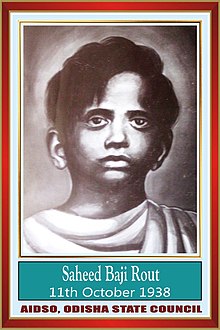Baji Rout: The Youngest Martyr of India's Freedom Struggle
Headlines:
Baji Rout: The 12-Year-Old Freedom Fighter Who Died for His Country
How Baji Rout Inspired India's Freedom Movement
The Legacy of Baji Rout Lives On
Introduction:
Baji Rout was a 12-year-old boy who died for his country in 1938. He was a freedom fighter who was shot by the British police when he refused to ferry them across the Brahmani River. Baji Rout is considered to be the youngest martyr of India's freedom struggle.
Baji Rout Early Life:
Baji Rout was born in the village of Nilakanthapur in the Dhenkanal district of Odisha in 1926. He was the youngest son of Hari Rout and Rania Devi. His father died when he was very young, and his mother raised him on her own. Baji Rout was a bright and cheerful boy who loved to play with his friends. He was also a very patriotic boy who loved his country very much.
The Freedom Struggle:
In the 1930s, India was under British rule. The British government was very oppressive, and the people of India were suffering under their rule. In 1938, a group of freedom fighters called the Prajamandal launched a movement against the British government. The Prajamandal movement was very popular, and many people joined it. Baji Rout was one of the many young people who joined the Prajamandal movement.
The Prelude to Heroism
During the tumultuous period of the Indian independence movement, Baji Rout found himself caught in the vortex of the freedom struggle. On October 26, 1938, when he was just twelve years old, an event unfolded that would etch his name in the annals of history.
The Incident at Nilakanthapur Beach
On that fateful day, a group of freedom fighters, led by Pandit Gopabandhu Das, had gathered to protest against the British Raj's oppressive rule. The British police, intent on suppressing the movement, advanced towards the crowd with batons and rifles. Sensing the imminent danger, Baji Rout, along with two of his friends, Dasarathi Sethi and Manoranjan Mohapatra, decided to take a stand against tyranny.
The Martyrdom of Baji Rout:
On the night of October 11, 1938, a group of British police officers came to the village of Nilakanthapur. They wanted to cross the Brahmani River, but Baji Rout refused to ferry them across. The police officers were angry, and they threatened to shoot Baji Rout if he did not ferry them across. Baji Rout stood his ground, and he refused to ferry the police officers across the river. The police officers then opened fire on Baji Rout, and he was shot and killed.
The Legacy of Baji Rout:
Baji Rout's death was a great loss to India. He was a young boy who gave his life for his country. His death inspired many people to join the freedom struggle, and he is considered to be a martyr of India's freedom movement. Baji Rout's legacy lives on, and he is remembered as a brave and patriotic boy who died for his country.
Commemorating the Martyr
To honor Baji Rout's sacrifice and keep his memory alive, several memorials and statues have been erected in various parts of India. The Government of Odisha has also recognized his courage and established educational institutions and scholarships in his name, ensuring that his legacy continues to shape the future generations.
Conclusion:
Baji Rout was a young boy from Odisha who died for his country in 1938. He was a freedom fighter who was shot by the British police when he refused to ferry them across the Brahmani River. Baji Rout is considered to be the youngest martyr of India's freedom struggle. His death was a great loss to India, but his legacy lives on. He is remembered as a brave and patriotic boy who died for his country.
Author: Shyamal



.png)
.png)



.jpg)


